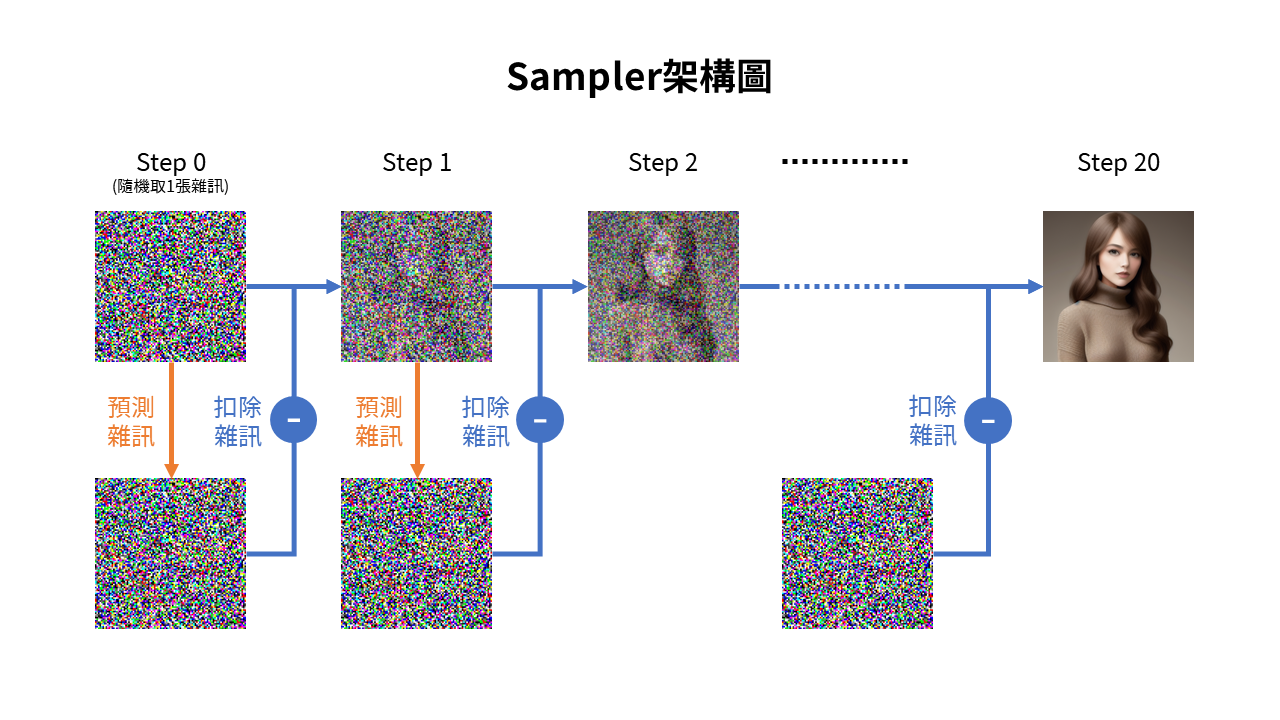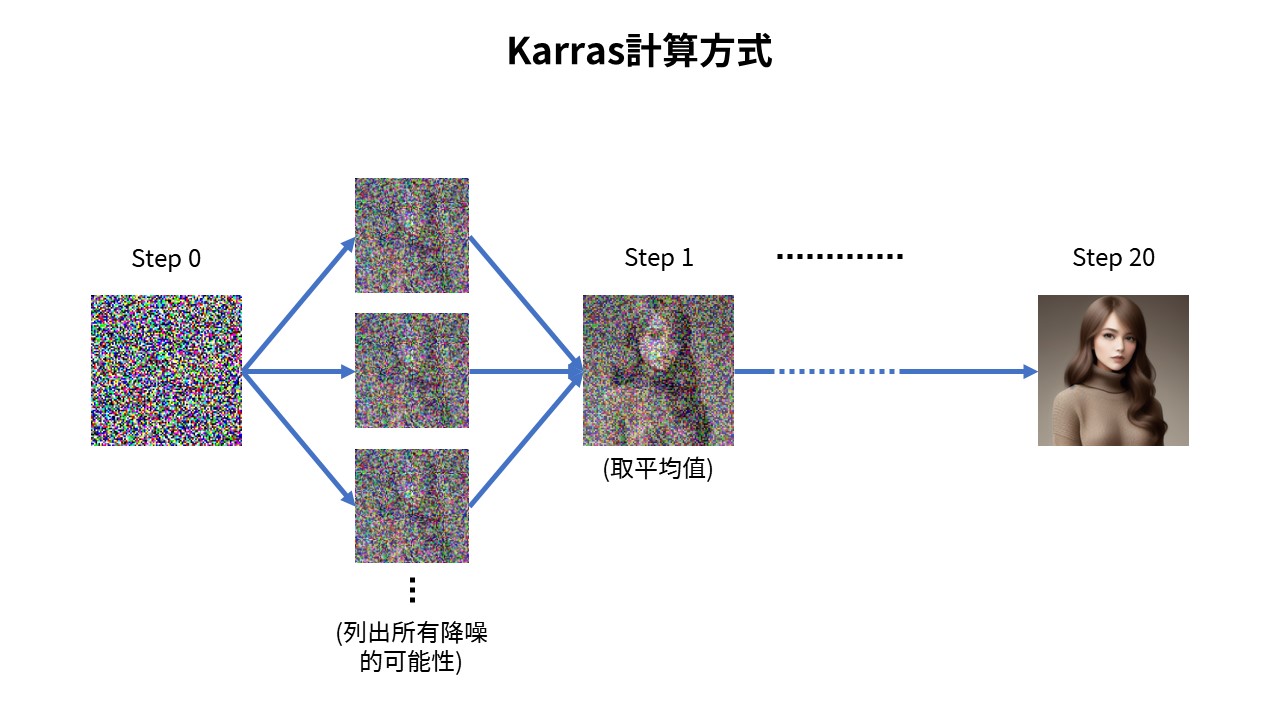全面理解:Stable diffusion中的Sampler
全面理解:Stable diffusion中的Sampler
簡介
Diffusion model在訓練過程中是將訓練圖集不停加噪,並學習其中的加噪過程,最後可以反向預測圖片的雜訊。所以Diffusion Model的功能基本上是一個雜訊預測器(noise predictor),透過預測一張圖中的雜訊並扣除來進行降噪,最終獲得一張完整的圖片(或是說,可看得清楚的圖片)。而取樣(sampling)是一種降噪的過程(denoising process),如圖1之架構圖所示,可基於各種取樣演算法(sampling method)來實現。

Diffusion model的原始加噪過程是以1000步為基礎,所以理論上降噪也必須執行1000步。而sampler的作用則是在1000步中每n步取樣一次以取得近似解,如step size=20表示將1000步切分取樣20次,因此sampler也稱作scheduler。如此一來可大大降低生成圖片的時間與硬體消耗,並且同時盡量保留原本圖片的樣貌。
各種取樣方法(Sampling method)說明
以下將介紹不同的sampling method之概念:
1. 常微分方程採樣 Ordinary Differential Equations(ODE) Sampler
原論文:Generative Modeling by Estimating Gradients of the Data Distribution
原作者部落格好讀版:https://yang-song.net/blog/2021/score/
宋颺等人提出[1],任何SDE可以在不改變邊際分佈的情況下將其轉換為常微分方程(ODE),因此在求解過程中,我們可將其看作是反向SDE的分布,此ODE稱為probability flow ODE,如下式:
重點摘要
- ODE Sampler是一種近似解。
- Step size會直接影響每次的sampling,也就是說取1步和取10步中的第1步會是不同的結果。
- ODE Sampler是片段線性的採樣。
- ODE比SDE更快,但品質較差。
Stable Diffusion Webui中的ODE方案
Euler:最簡單的sampler,它使用Euler’s method來解ODE,並且sampling的過程中不會添加任何隨機雜訊。
*此sampler之實作是在Tero Karras等人於《Elucidating the Design Space of Diffusion-BasedGenerative Models》論文中的Algorithm 2。[2]Heun:改進後的Euler(或稱二階Runge–Kutta法),相較Euler更加準確但速度較Euler慢約50%,因為它在一次step中先做一次euler並取中間值後,
又再做第二次euler
以取得最終結果。[3]
*此sampler之實作來自Tero Karras等人之論文中的Algorithm 1。[2:1]
LMS(Linear multistep):速度和Euler相差無幾,但較準確。因為LMS在sampling時是將以往的所有步數取平均來計算,以提高準確度。[4]
PLMS(Pseudo linear multistep):LMS的變種,是直接在流型上解ODE。[4:1]
2. 原始採樣 Ancestral samplers
原始採樣在每個sampling step添加隨機雜訊,這使得每次的sampling都會有些微的變化,且每步的sampling只與前次有關,如下式:
因此,如果想要使每次的生成都有不同的變化(如:飾品、花紋等小細節),可考慮使用原始採樣。請注意,原始採樣的收斂性(converge)較低,可能會需要較多的step size才能趨近於穩定,且受eta參數影響。
Stable Diffusion Webui的原始採樣方案(有a的即為原始採樣)
- Euler a:Euler的原始採樣版,基於k-diffusion實作。通常可在20~30步內生成良好圖像。[5]
- DPM++ 2S a
- DPM++ 2S a Karras
- DPM2 a
- DPM2 a Karras
3. DPM(Diffusion Probabilistic Model) Samplers
DPM系列是由北京清華大學的Cheng Lu等人提出的sampling method,分為DPM、DPM++兩代,DPM2則是後人所改良的最新版。
(1) DPM
原論文:DPM-Solver: A Fast ODE Solver for Diffusion Probabilistic Model...[6]
- DPM fast:在k-diffusion中實現的固定步長採樣法,可適用於step size<20的情況。
- DPM adaptive:在k-diffusion中實現的自適應步長採樣法。須注意生成速度可能受影響,因為它不保證在指定step size內完成取樣。[7]
(2) DPM++
原論文:DPM-Solver++: Fast Solver for Guided Sampling of Diffusion...[8]
DPM++有以下解方:
- 2S a:在k-diffusion中實現二階單步並加入原始採樣法。(原論文之Github提供1/2/3階與單/多步選擇可進行實驗)
- 2M:在k-diffusion中實現二階多步採樣。
- SDE:使用隨機微分方程式(Stochastic Differential Equations)來求解。
Stable Diffusion Webui的DPM++方案
- DPM++原版
- DPM++ 2S a
- DPM++ 2M
- DPM++ SDE
- DPM++ Karras版 (Karras系列詳細介紹請看5. 部分)
- DPM++ 2S a Karras
- DPM++ 2M Karras
- DPM++ SDE Karras
(3) DPM2
由Katherine Crowson在K-diffusion自創並實作的DPM改良版,受sigma與eta參數影響。
Stable Diffusion Webui的DPM2方案
- DPM2原版
- DPM2
- DPM2 a
- DPM2 Karras版 (Karras系列詳細介紹請看5. 部分)
- DPM2 Karras
- DPM2 a Karras
4. DDIM(Denoising Diffusion Implicit Models) Sampler
原論文:Denoising Diffusion Implicit Models[9]
5. Karras Samplers
原論文:Elucidating the Design Space of Diffusion-Based Generative Models[2:2]
Karras是由Nvidia研究團隊所研發的sampling method,以第一作者Tero Karras的名子命名。其基於noise schedule來實作sampling,在每次sampling時是將所有的denoise可能性取平均來計算,使需要的sample steps顯著下降,如圖2概念圖所示。

Stable Diffusion Webui的Karras方案
- LMS Karras
- DPM2 Karras
- DPM2 a Karras
- DPM++ 2S a Karras
- DPM++ 2M Karras
- DPM++ SDE Karras
6. UniPC Sampler
原論文:UniPC: A Unified Predictor-Corrector Framework for Fast Sampling...[11]
原作者部落格好讀版:https://unipc.ivg-research.xyz/
最新的sampler(2023),由Wenliang Zhao等人所提出。基於ODE Solver中的預測校正的啟發,可在5~10步內產生高品質的圖像。[7:1]
總結
基本上Sampler(sampling method)的選擇與美觀度較無關聯,只與是否能在最少的step size還原出最接近原圖像有關係。
- 目前以最新的UniPC為首選,因為它可以在最低的step size中產生高品質的圖像。其次可選擇DPM++ 2M與DPM++ 2M Karras。
- 想要每次都有不同變化,可選擇Euler a、DPM++ SDE及DPM++ SDE Karras等。
資料來源
Y. Song and S. Ermon, “Generative modeling by estimating gradients of the data distribution,” arXiv [cs.LG], 2019. ↩︎
T. Karras, M. Aittala, T. Aila, and S. Laine, “Elucidating the design space of diffusion-based generative models,” arXiv [cs.CV], 2022. ↩︎ ↩︎ ↩︎
Wikipedia contributors, “Heun’s method,” Wikipedia, The Free Encyclopedia, 07-Jun-2023. [Online]. Available: https://en.wikipedia.org/w/index.php?title=Heun%27s_method. ↩︎
“Samplers,” Stable Diffusion UI v2, 15-Mar-2023. [Online]. Available: https://stable-diffusion-ui.github.io/docs/samplers/. [Accessed: 08-Jul-2023]. ↩︎ ↩︎
“Euler Ancestral scheduler,” Huggingface.co. [Online]. Available: https://huggingface.co/docs/diffusers/api/schedulers/euler_ancestral. [Accessed: 08-Jul-2023]. ↩︎
C. Lu, Y. Zhou, F. Bao, J. Chen, C. Li, and J. Zhu, “DPM-solver: A fast ODE solver for diffusion probabilistic model sampling in around 10 steps,” arXiv [cs.LG], 2022. ↩︎
Andrew, “Stable diffusion samplers: A comprehensive guide,” Stable Diffusion Art, 28-Mar-2023. Available: https://stable-diffusion-art.com/samplers/. ↩︎ ↩︎
C. Lu, Y. Zhou, F. Bao, J. Chen, C. Li, and J. Zhu, “DPM-solver++: Fast solver for guided sampling of diffusion probabilistic models,” arXiv [cs.LG], 2022. ↩︎
J. Song, C. Meng, and S. Ermon, “Denoising Diffusion Implicit Models,” arXiv [cs.LG], 2020. ↩︎
“扩散模型之DDIM,” 知乎专栏. [Online]. Available: https://zhuanlan.zhihu.com/p/565698027. [Accessed: 08-Jul-2023]. ↩︎
W. Zhao, L. Bai, Y. Rao, J. Zhou, and J. Lu, “UniPC: A unified predictor-corrector framework for fast sampling of diffusion models,” arXiv [cs.LG], 2023. ↩︎
